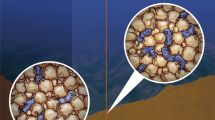Abstract
We develop a method to capture marine bacterial strains at high efficiency to replace the conventional two-step collecting method. Lab-made, Fe3O4 magnetic beads were used to firstly verify the feasibility of capture in artificial seawater, using Bacillus velezensis. Almost 100% of the bacteria could be captured and separated within 10 min. Then, the salinity of capture medium was proved to have the most marked effect on the capture process. After that, the broad application and high efficiency of capture were verified using four different bacterial strains from the Pacific Ocean. Subsequently, through adjusting the salinity, the capture efficiency for Pseudoalteromonas sp. and Halomonas meridiana was increased from 20 to ~ 80% in a seawater system, which was used to simulate the in-situ capture conditions. Finally, mixed strains in seawater were successfully captured, and their genomic DNAs were isolated and analyzed. Bare Fe3O4 magnetic beads were initially applied to capture marine microorganisms and this method is convenient and highly efficient and thus has great potential to replace the conventional two-step method.



Similar content being viewed by others
References
Jaiganesh R, Sampath KN (2012) Marine bacterial sources of bioactive compounds. Adv Food Nutr Res 65:389–408. https://doi.org/10.1016/B978-0-12-416003-3.00025-1
Simmons TL, Coates RC, Clark BR et al (2008) Biosynthetic origin of natural products isolated from marine microorganism-invertebrate assemblages. Proc Natl Acad Sci USA 105:4587–4594. https://doi.org/10.1073/pnas.0709851105
Tziveleka LA, Vagias C, Roussis V (2003) Natural products with anti-HIV activity from marine organisms. Curr Top Med Chem 3:1512–1535. https://doi.org/10.2174/1568026033451790
Arif JM, Al-Hazzani AA, Kunhi M, Al-Khodairy F (2004) Novel marine compounds: anticancer or genotoxic. J Biomed Biotechnol 2:93–98. https://doi.org/10.1155/S1110724304307060
Orcutt BN, Sylvan JB, Knab NJ, Edwards KJ (2011) Microbial ecology of the dark ocean above, at, and below the seafloor. Microbiol Mol Biol Rev 75:361–422. https://doi.org/10.1128/MMBR.00039-10
Silva RM, de Oliveira RR, Pivel MAG et al (2018) Microbial diversity from chlorophyll maximum, oxygen minimum and bottom zones in the southwestern Atlantic Ocean. J Mar Syst 178:52–61. https://doi.org/10.1016/j.jmarsys.2017.10.008
Yan T, Bu J, Fu X (2000) Analysis on the current status and development trend of overseas seabed sampling technology—one of the submarine sampling techniques. Geol Sci Technol Inf 19:66–70
Qin H, Chen Y, Gu L et al (2009) The development of gas-tight sampling techniques. J Trop Oceanogr 28:42–48
Zhang J, Liu X, Qian K (2010) Advances in microbial enrichment methods and applications. J Microb Inf 5:176–180
Yang J, Chen Y, Zou M et al (2013) Advances on application of superparamagnetic nanoparticle in biochemical separation and analysis. J Instr Anal 32:1270–1276
Huang Y (2010) Functional magnetic particles for bacteria capture and on-line preconcentration of metal ions. Dissertation, Nankai University
Jin Y, Geng X, Huang J (2013) Preparation and bacteria capture research of cross-linked magnetic chitosan microsphere. Food Sci Technol 38:266–269 & 273
Kell AJ, Stewart G, Ryan S et al (2008) Vancomycin-modified nanoparticles for efficient targeting and preconcentration of Gram-positive and Gram-negative bacteria. ACS Nano 2:1777–1788. https://doi.org/10.1021/nn700183g
Qiu J, Fan X, Shen S, et al. (2006) Study on the adsorption capacity of lab made magnetic particles to the common food-borne pathogenic bacteria. Mod Prev Med 33:4–5 & 11. https://doi.org/10.13982/j.mfst.1673-9078.2019.2.026.
Li Q, Chen P, Ren C (2012) Comparison of different magnetic beads for adsorption of pathogenic bacteria. J Hyg Res 41:293–297
Wilson WW, Wade MM, Holman SC et al (2001) Status of methods for assessing bacterial cell surface charge properties based on zeta potential measurements. J Microbiol Methods 43:153–164. https://doi.org/10.1016/S0167-7012(00)00224-4
Schwertmann U, Cornell RM (1991) Iron oxides in the laboratory: preparation and characterization, 1st edn. VCH Publishers, Weinheim
Cotton FA, Wilkinson G (1988) Advanced inorganic chemistry, 5th edn. Wiley, New York
Gupta AK, Gupta M (2005) Synthesis and surface engineering of iron oxide nanoparticles for biomedical applications. Biomaterials 26(18):3995–4021. https://doi.org/10.1016/j.biomaterials.2004.10.012
Lin M (2007) Diversity of cultivated bacteria isolated from deep seas in tropical Pacific Ocean and identification of a new species Oceanicola Eastpnp sp. nov. Third Institute of Oceanography, State Oceanic Administration, China
Shi M (2015) Removal of Cr from aqueous solutions with porous stainless steel supported iron oxides membranes. Dissertation, Northwest A&F University
Mancera RL (1998) Does salt increase the magnitude of the hydrophobic effect? A computer simulation study. Chem Phys Lett 296:459–465. https://doi.org/10.1016/S0009-2614(98)01080-X
Mancera RL (1998) Computer simulation of the effect of salt on the hydrophobic effect. J Chem Soc Farad Trans 94:3549–3559. https://doi.org/10.1039/A806899B
Li Y, Zhou D, Xia X et al (2017) Rapid detection of Salmonella in shrimp by immunomagnetic separation combined with real-time PCR. Mod Food Sci Technol 33:235–242. https://doi.org/10.13982/j.mfst.1673-9078.2017.11.034
Kennedy J, Marchesi JR, Dobson AD (2008) Marine metagenomics: strategies for the discovery of novel enzymes with biotechnological applications from marine environments. Microb Cell Fact 7:1–18. https://doi.org/10.1186/1475-2859-7-27
Acknowledgements
We would like to acknowledge the financial support by the National Key Research and Development Program of China (2016YFF0202303) and the National Key Scientific Instrument and Equipment Project of NSFC (21627812). We would like to thank Prof. Runying Zeng from Third Institute of Oceanography, State Oceanic Administration, Xiamen, China for the provision of strains and environmental samples. The authors would like to thank Mr. Zheng Lin Tan (ORCID: 0000-0001-6447-3788) for useful discussion, critical review technical and language editing.
Author information
Authors and Affiliations
Corresponding author
Ethics declarations
Conflict of interest
The authors declare that they have no conflict of interest.
Additional information
Publisher's Note
Springer Nature remains neutral with regard to jurisdictional claims in published maps and institutional affiliations.
Electronic supplementary material
Below is the link to the electronic supplementary material.
Rights and permissions
About this article
Cite this article
Zheng, Y., Jian, X., Xing, Xh. et al. Highly Efficient Capture of Marine Microbial Strains in Seawater Using Bare Fe3O4 Magnetic Beads. Curr Microbiol 77, 1210–1216 (2020). https://doi.org/10.1007/s00284-020-01923-6
Received:
Accepted:
Published:
Issue Date:
DOI: https://doi.org/10.1007/s00284-020-01923-6




